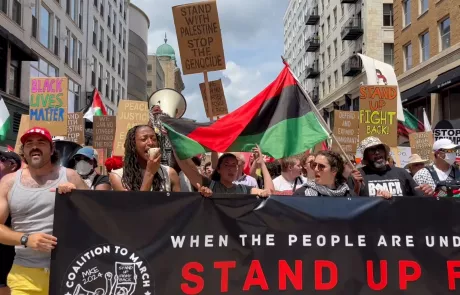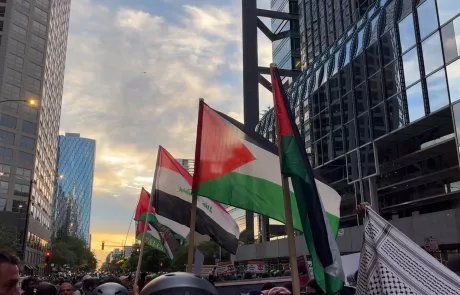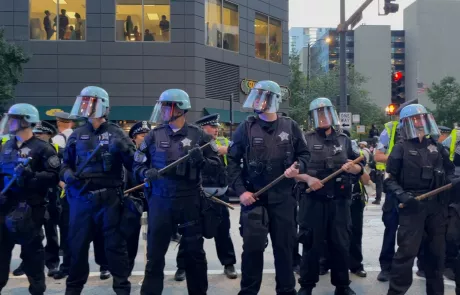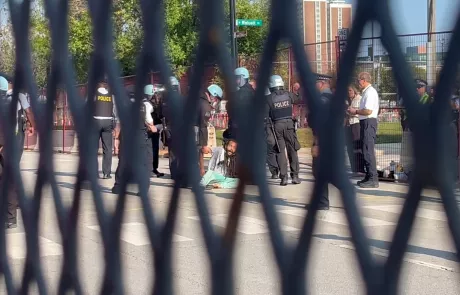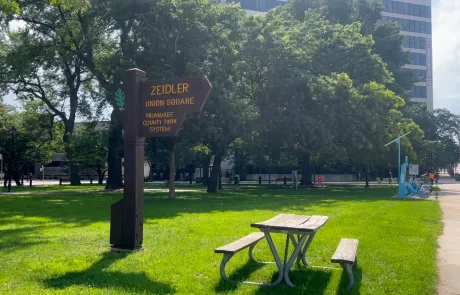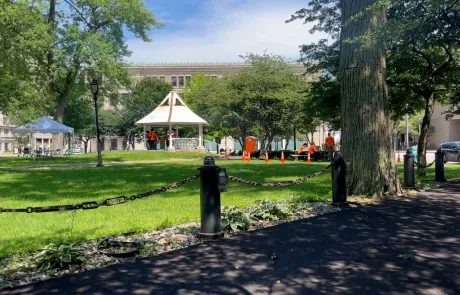Table of Contents
How Milwaukee and Chicago circumvented free speech at the RNC and DNC

ezellhphotography / Shutterstock.com
Peaceful protest outside the 2024 Democratic National Convention in Chicago.
Ahead of the 2024 election, the Republican National Convention and Democratic National Convention brought thousands of delegates, high-profile politicians, lobbyists, and media commentators to Milwaukee and Chicago. As expected, the events attracted thousands of protesters, who descended on the metropolitan areas for each of the near week-long quadrennial affairs.
Each city expected a throng of demonstrators, but from what FIRE witnessed on the ground, the number of media and police officers seemed to greatly outnumber demonstrators at both conventions. Coalition organizers partially blamed this on lengthy legal battles, insufficient platforms for protected speech, and city leaders establishing a culture of fear around free expression.
‘Free speech zones’ at the RNC
The highly anticipated convention season began in mid-July with the RNC in Milwaukee. Despite court challenges, the city largely restricted protest activity to two “demonstration zones” far from RNC foot traffic.
How were protesters kept so far from the action?
The story begins after the RNC announced that its convention would be held in Milwaukee. On April 12, 2023, more than a year before the event took place, the Coalition to March on the RNC applied for a permit to demonstrate. After more than a year of waiting, it had still not been approved. The American Civil Liberties Union of Wisconsin filed a lawsuit against the City of Milwaukee on behalf of a coalition of at least 71 organizations, alleging that Milwaukee’s broad restrictions on First Amendment activity were unconstitutional.
In the lawsuit filed on June 5, the coalition alleged that Milwaukee passed rules that infringed on protesters’ rights, including an ordinance passed in March that allowed the city to hold off on granting permits and disclosing official march routes until the eleventh hour. Less than six weeks ahead of the convention, the coalition still had not been given notice about its demonstration permit and parade route, the lawsuit stated.
“I think the city is just kind of sending a message: If you want to do things the right way, this is how we’re going to treat you,” Omar Flores, co-chair of the Coalition to March on the RNC, told FIRE after the convention. “We’re not going to make it easy. We’re not going to respond to you, and ultimately, you’re going to have to lawyer up to get any real response from us.”

By June 21, the city released its hard security perimeter for the forthcoming event and announced that there would be two demonstration zones. Notably, one of the demonstration zones, Zeidler Union Square is more than half a mile away from the convention’s main headquarters at the Fiserv Forum.
Just a week ahead of the convention, a federal judge declined to issue a preliminary injunction against most of the demonstration rules, leaving them and the city’s proposed parade route in place. Judge Brett Ludwig said in his ruling that although protesters have the right to march at the RNC, “the First Amendment does not allow them to protest or parade in any way they choose.” Ludwig noted that the majority of the security plan was a valid time, place, and manner regulation on speech.
The Coalition to March on the RNC kept applying pressure, however, and on the Friday before the convention, reached a handshake agreement with the city that allowed the group to march within sight and sound of the Fiserv Forum.
Flores said conditions were “ripe” for people to not show up, and while they still had a decent turnout, it was an “extremely uphill battle the entire time.”
“The city holding things off until the last minute is definitely a political strategy on their end,” Flores said after the event. “I think what they were essentially trying to do is scare people out of doing the RNC. The city really created this culture of fear, this idea that we don’t approve of any type of protest.”
The Coalition to March on the RNC held a pre-planned demonstration on Monday, July 15, where they rallied across the river from the Fiserv Forum at Red Arrow Park, followed by a family-friendly march. The coalition commended the 120 affiliated organizations and 3,000 people who attended the demonstration, but it initially expected upwards of 10,000 attendees, the Associated Press reported.
The week continued with few to no protesters at either of the two free speech zones, and FIRE saw only about a dozen protesters outside the RNC security gates over the next two days. Though more than 100 individuals or groups signed up to speak, the no-show rate was more than 80%, according to the AP.
Flores told FIRE the march was a success, but said the strict protest restraints undoubtedly discouraged some people from traveling to exercise their constitutional rights. He also pointed to a heavy law enforcement presence that created a “culture of fear” for amateur organizers and said that the July 13 assassination attempt against former President Donald Trump may have deterred some people from attending.
FIRE ON THE GROUND AT THE RNC: WE NEED TO TALK, NOT SHOOT
“It was extremely disappointing for us to see the lack of activity that week. This is because of the precedent that the city set,” Flores said. “Honestly, I think it’s something we’re going to be seeing more frequently. There’s a lot of intensity growing on each side. I think that will be used as an excuse to get rid of First Amendment rights.”
A desolate demonstration zone
FIRE encountered one demonstrator, Alexis Pleus, who traveled from Binghamton, New York for the opportunity to reach big-name Republican Party decision-makers and advocate for her organization, Truth Pharm, which aims to reduce the stigma about opioid addiction and to educate the public and advocate for policies to reduce harms from substance use. Pleus founded Truth Pharm in 2015 after tragically losing her son to a drug overdose the year before and was excited to share her organization’s vision to RNC-goers. She was shocked to arrive in Milwaukee and find a desolate demonstration zone with minimal foot traffic.
“It’s very frustrating to me, because I was looking forward to coming to a place to reach people that I don’t always get to reach,” Pleus said. “But now I’m not going to have that opportunity, because they put us over in a park a mile from here where nobody’s at. Without a doubt, there are people who probably did not share their message.”
FIRE attended Pleus’ scheduled speech at the Zeidler Union Square free speech zone, which only saw about a dozen attendees. In fact, FIRE walked past the area multiple times over those few days and found a sea of security guards basically twiddling their thumbs, zero demonstrations, and few RNC attendees passing by.
“This bullshit of putting people who are demonstrating and people who deserve to have a voice at this event, putting us out here three-quarters of a mile away from the activity is, is crap,” Pleus yelled during her Wednesday speech. “Our message is not political. Red and blue can do the right thing, and you are putting us out here where no one can hear the message. How dare you?”
The specter of 1968 at the DNC, and yet another legal tussle
Next up was the DNC, held in Chicago, for the second time since the internationally infamous 1968 convention — one that saw numerous violent clashes between police and protesters, and which left a stain on the Windy City for decades. The similarities between the lead-up to the 2024 DNC and the 1968 catastrophe were numerous, and evident nationwide.
President Joe Biden relinquished his bid for reelection ahead of the convention as did President Lyndon Johnson more than 50 years ago. The political climate back then also saw fervent demonstrations around the Vietnam War — akin to protests today over the Israel-Hamas war in Gaza.

With the specter of 1968 hovering over the event, as well as another legal back-and-forth between protesters and Chicago city officials, demonstrators told FIRE their speech was suppressed during the DNC. A few demonstrators even accused Chicago officials of making content-based restrictions on speech.
“Because they don’t like the content of our protest, they were going to all these lengths to restrict our free speech,” Faayani Aboma Mijana, a spokesperson for the Coalition to March on the DNC, told FIRE.
Multiple groups with the Coalition to March on the DNC — an organization of more than 200 organizations united to protest the Democratic Party’s policies on Gaza — filed a lawsuit in March against the City of Chicago, alleging two counts of First Amendment violations after the city denied its parade permits.

According to the lawsuit, city officials initially offered alternative routes for the coalition, all of which were miles away from the United Center, the main DNC headquarters. The city eventually offered a 1.4 mile route within sight and sound of the convention, but coalition organizers demanded a longer route to accommodate the expected tens of thousands of demonstrators.
But on Aug. 12 a federal judge affirmed that the city’s suggested parade route within sight and sound of the United Center satisfied the First Amendment.
The city also eventually approved the coalition’s right to assemble in Chicago’s Union Park and Park 578, but denied the group access to sound amplification, a stage, tents or canopies, and portable restrooms, according to a coalition press release.
“At every turn, we organize people and engage in legal struggle to fight for everything we have to preserve our First Amendment right,” Mijana told FIRE.

On Aug. 16, the city finally conceded to protesters’ demands, allowing them a stage and amplified sound to spread their message during the group’s Aug. 19 and 22 demonstrations, according to legal documents. The city also allowed the group seven portable toilets.
“The battle to get here was long and arduous,” Mijana said. “It speaks to the hypocrisy of some of these politicians who like to think that they’re for free speech, but they’re actually kind of selective of who they want to have free speech.”
Despite this small victory, another coalition organizer, Kobi Guillory, told FIRE the attempts to suppress the group’s speech impacted the total number of demonstrators who descended on Chicago. While 20,000 people attended the coalition’s first march and 11,000 attended the second, the coalition’s attorney Chris Williams estimated ahead of the marches that it would be closer to 40,000 or 50,000 participants in total, the Chicago Sun Times reported.
“We know it has limited some people’s speech,” Guillory told FIRE during the first march on Aug. 19. “We’re going to do everything in spite of that to make sure people are heard and seen. The state does limit people’s free speech… We just have to keep fighting.”
Should protesting be this difficult?
In the end, each convention still saw thousands of protesters exercising their right to free expression and peaceful assembly. But the legal skirmishes and broad restrictions on protected expression leading to diminished turnouts raise the question: Should it be this hard to exercise one’s First Amendment rights?
“These things shouldn’t be fought for,” Mijana told FIRE. “The unfortunate truth is that we may not get everything we fight for, but we fight for everything we get. I’d like to see our free speech rights protected more.”

Recent Articles
FIRE’s award-winning Newsdesk covers the free speech news you need to stay informed.

No president gets to decide who deserves a lawyer
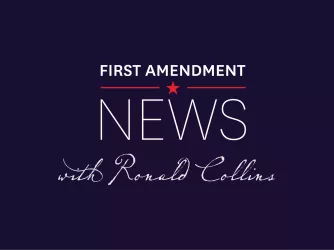
Free speech in an age of fear: The new system loyalty oaths – First Amendment News 464

AI is new — the laws that govern it don’t have to be



